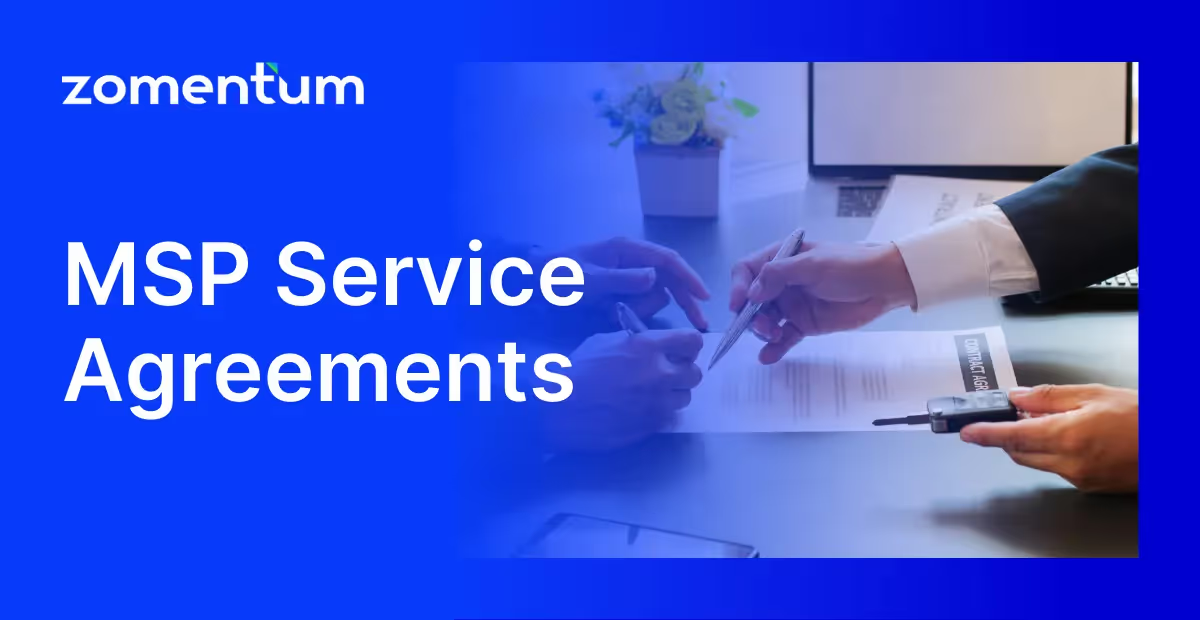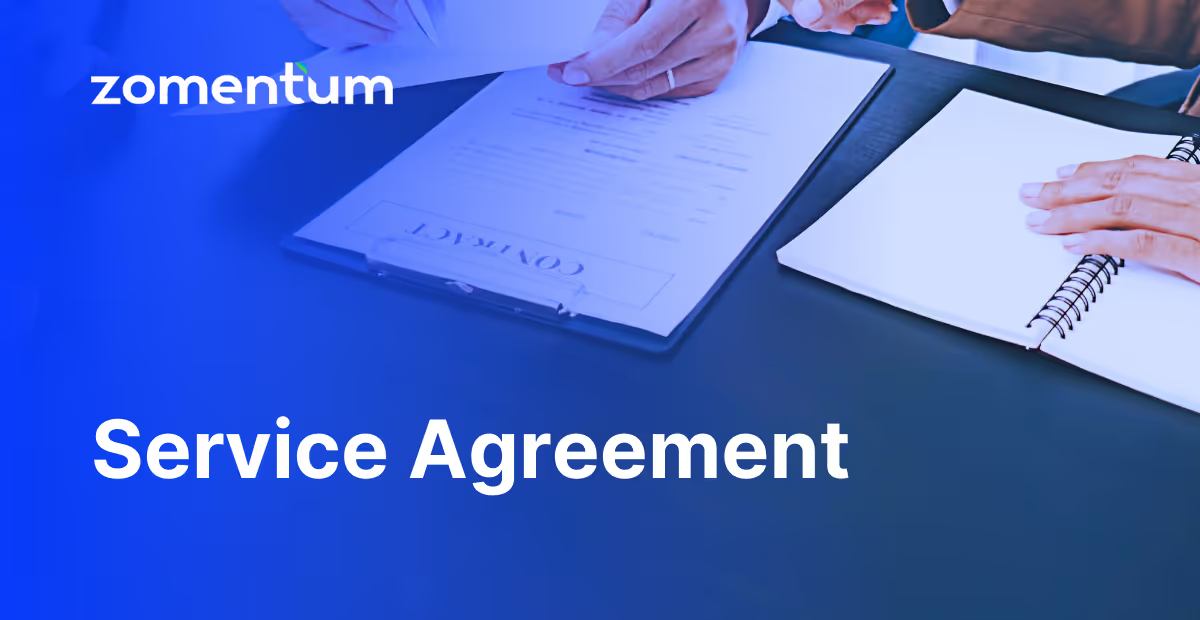Complete Guide to MSP Service Agreements

Building trust is key to running a successful business, and the same applies to MSPs. When you have a mutual understanding with your clients, it's a win-win for everyone. But what if your client asks for something beyond your scope of responsibilities? What do you do if there’s a misunderstanding regarding payments?
Most MSPs have been operating on a break/fix model for a long time, but it’s ineffective if your goal is to build long-term relationships with your clients.
If you want to set the right expectations with your prospects and client base, it's time to switch gears and focus on creating MSP service-level agreements with them. Having an MSP SLA or a managed services agreement helps you clearly describe the scope of your services, set appropriate payment terms, and outline each party's responsibilities in the service relationship.
This guide will tell you everything you need to know about managed service agreements and how to use them for your business.
What is a Managed Service Provider Agreement?
A managed service agreement (MSA), or an MSP agreement, is a written contract or agreement between a provider and its client. The agreement defines the kind and level of service the provider will deliver. It outlines the responsibilities of the provider and client, including services offered, minimum response time, liability protection for the provider, and a payment structure agreed to between both parties.
Most managed services agreements comprise terms and conditions that define all related transactions between the provider and client. A managed services agreement reassures clients that they can rely on you. Defining the offerings within an agreement benefits the MSPs by allowing for a repeatable way to scale and increase their business profitability and helps establish a long-lasting business relationship with the client.
For example, an online fashion business can hire an offsite IT company to look after its IT needs, such as protecting the business' data, hosting services, and providing general IT support for a fixed time period. To ensure that this is done right, they'll need a Managed Services Agreement.
What is the difference Between a Managed Service Agreement and a Master Service Agreement (MSA)?
A Managed Service Agreement includes service offerings, dedicated software or infrastructure, dedicated personnel, complete access or restrictive control over software or infrastructure, service-level agreements, and better pricing rates.
A Master Service Agreement is a document that consolidates the agreement between the provider and its client across all operational matters, defining engagement processes, pricing, payment terms and procedures, confidentiality, liability, and dispute resolution.
A master service agreement essentially serves as a framework for future contracts and transactions. It's a template for future dealings that allows a provider and a client to engage on multiple projects without having to draft and execute a new contract for every new project.
On the other hand, a managed service agreement (MSA) is a more targeted agreement that specifically addresses the provision of managed services and may have a narrower scope.
What is the difference Between a Managed Service Agreement (MSA) and a Statement Of Work (SOW)?
When an MSP and a client have agreed upon and signed a master service agreement (MSA), the parties must also agree to and sign a statement of work (SOW) before they begin their liaison.
A statement of work (SOW) is a document that describes in detail how a project will be executed. An SOW ensures that all involved parties are aligned on the project's work requirements and project-specific tasks, set timelines, deliverables, and pricing. An SOW offers details about a specific aspect of the relationship, like a service or a project agreement, whereas an MSA describes the terms and conditions for the entire relationship.
Think of an MSA as a book that governs the business relationship and the SOW as a chapter within that book.
Why Does an MSP Need a Managed Service Agreement?
A managed service agreement makes it easier to draft a solution path and define the working parts of the business relationship with the client. The agreement is designed to set realistic expectations for the client while documenting legal formalities for both the MSP and the client that shall require attention in due course.
Here are the benefits of signing an MSP SLA:
- A well-written MSA can make your business dealings with the client easier.
- A good MSA doesn't just discuss the terms and conditions of the payment period but also controls the mode through which you want to get paid.
- An MSA can handle the renegotiation and renewal of the contract with the client.
- It manages the overall relationship between the service provider and the client.
- A well-drafted MSA ensures that both parties know their rights and duties and understand that any concerns will be promptly addressed.
- An MSP SLA helps resolve any issues by laying out consequences for expectations that are not met if either party fails to meet the conditions.
What Should an MSA Include?

Now that you know the importance of creating an MSP SLA, it's time to draft one yourself. Here are the crucial terms and conditions to include in an MSP SLA:
1. Services Provided
The beginning of the managed service agreement should clearly outline the services of solutions and products a client can expect from their MSP, the scope of your services, the hours of operation, and a list of inventory of any hardware or software that is part of the package.
2. Performance Tracking
A list of MSP KPIs, reporting processes, and expected performance measurements based on a mutual agreement between the MSP and the client should be included in the contract.
What is the difference Between a Managed Service Agreement and a Master Service Agreement (MSA)?
3. Problem Management and Troubleshooting
The agreement should include an overview of what the parameter of a problem is and the process for accelerating the issue to the MSP. A root-cause analysis will also be conducted after the problem has been resolved to regulate the underlying source of the issue and prevent it from repeating.
4. Responsibilities
This part should include each party's area of responsibility, involving any software or hardware if the client is responsible for maintaining any infrastructure and services the MSP provides.
5. Escalation
All parties involved should know what to expect and how to conduct that determines the workflow and eases communication. All in all, you should have an established order of operation for different types of emergencies.
6. Reporting
An overview of an accurate and transparent reporting process should be mentioned clearly, as this is fundamentally important for an effective partnership between the MSP and the client. Specify the different approved ways a client can open a ticket with varying options depending on whether the request comes inside or outside support hours.
7. Resolution
The MSA should include the time it takes to resolve different matters based on the severity of the issues and also contain information about working outside your typical business hours.
8. Availability
An MSA must mention the uptime hours, contact details in case of downtime, extra charges owing to downtime, or any specific time when services are unavailable for any technical glitches or other reasons. While committing to keeping your client systems up and running, be realistic and specific, as miscommunication and vague terms may lead to disputes.
9. Termination
Mention the conditions for termination, as this will avert potential future disagreements and protect both MSPs and their clients.
10. Pricing and Billing
Have a clear outline of the pricing and billing structure for the provided services, and that should include any taxes, discounts, or charges that may apply and also mention any payment terms and conditions.
11. Service Level Targets
This section should include the targets the MSP is expected to meet, including response times, availability, and security measures. It should also include disaster recovery plans, security audits, and malware protection.
12. Data Protection and Privacy
The MSA should include a section on what you'll do to protect your client's sensitive data or proprietary information. Describe your security protocols and include what actions will be taken in case of a security breach.
13. Force Majeure
Force Majeure is the section of the Managed Service Agreement where you specify any damages or losses that might occur that are not in your control. Take some time to carefully consider any foreseeable crisis that could impact your ability to work.
Carefully define the response you would like your client to take in crises so that you can maintain a stable working relationship and protect your business in unforeseen circumstances.
Best Practices to Follow When Creating MSP Service Agreements

While every business follows different ways to draw up and create service agreements, here are a few best practices MSPs should follow:
1. Avoid Scope Creep
Ensure your MSP service agreements are clear about your terms and conditions, especially highlighting the tasks that do not come under your purview. It’s best to create a separate section within the agreement that enlists the things that aren’t included within your scope.
2. Set Realistic Benchmarks for KPIs
Every MSP SLA should include specific KPIs, like device uptime and incident response times. These numbers are easy to explain to customers and give them a clear benchmark around what to expect from your service. Metrics should be realistic, easy to quantify, and relevant.
3. List Out Minimum Standards
Make sure your client has the basic requirements you would need to execute your service with minimal hassle. This could include:
- Patch and update levels
- Equipment and hardware states
- Operating systems
- Applications
4. Standardize the Process
Instead of having to draft the same document repeatedly each time you sign a new client, use a readymade managed service agreement template to save time.
5. Avoid Legalease
Unless your clients are law firms exclusively, most people don’t understand the legal jargon included in agreements and contracts. MSP SLAs should be kept simple and to the point where both parties are aware of the terms and conditions.
6. Regularly Review and Update the SLA
An SLA is not a static document but should evolve with the changing needs of the business. Regularly review the SLA to ensure it remains aligned with the evolving objectives, technologies, and industry standards. It also shows you have a proactive approach and strive for continuous improvement.
7. Include a Customer Compensation Clause
Most clients initially hesitate to sign an MSP service agreement because they believe it's unnecessary. The best way to gain their trust is to include a clause that fairly compensates them in case of a breach of contract.
For example, if there's a mishap when installing certain software, you can offer them a 5% discount on the next month’s service fee.
8. Add a Conflict Resolution Clause
In case of any conflict between the parties, it’s always safe to add a clause that dictates how the disagreement would be resolved. Make sure to offer a dispute resolution mechanism that benefits all parties involved.
Wrapping Up
Creating and managing MSP SLAs is no easy task, and it only gets more complicated as your business grows. From adding different clauses to regularly revising the agreements for multiple clients, it is a time-consuming process.
Luckily, Zomentum can save the day. Instead of manually tracking all the terms and conditions of your MSP SLAs, Zomentum’s contract management feature allows you to view all your contracts in one place, track important dates, and receive alerts when it's time for renewals or payments.
Additionally, it comes with the ability to standardize and automate processes across functions, helping you with both operations and managing customer relationships. Say goodbye to the enormous piles of paperwork and focus on growing your business with Zomentum.
Book a demo with us today and revamp how you manage your agreements.
Suggested Blogs

What’s new in Zomentum - December 2019
.avif)
Zomentum Announces the Top Influential Partners of 2023: Leading the Way in Growth and Innovation

